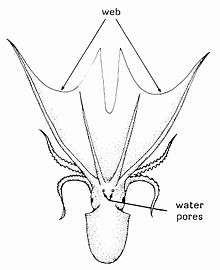Paralarva

Octopus paralarva

Squid paralarva: Psychroteuthis glacialis
.jpg)
Grimalditeuthis bonplandi paralarva
.jpg)
Grimalditeuthis bonplandi adult
Paralarvae (singular: paralarva) are young cephalopods in the planktonic stages between hatchling and subadult. This stage differs from the larval stage of animals that undergo true metamorphosis.[1] Paralarvae have been observed only in members of the orders Octopoda and Teuthida.[2]
The term was first introduced by Richard E. Young and Robert F. Harman in 1988.[2]

Chtenopteryx sicula paralarvae. Left: Two very young paralarvae. The circular tentacular clubs bear approximately 20 irregularly arranged suckers. Two chromatophores are present on each side of the mantle. Centre: Ventral, dorsal and side views of a more advanced paralarva. An equatorial circulet of seven large yellow-brown chromatophores is present on the mantle. Posteriorly the expanded vanes of the gladius are visible in the dorsal view. Right: Ventral and dorsal views of a very advanced paralarva.
See also
References
- ↑ "Paralarvae". Larval Images: Larval forms diverse and beautiful!.
- 1 2 Richard Edward Young & Robert F. Harman (1988). ""Larva", "Paralarva", and "Subadult" in Cephalopod Terminology". Malacologia. 29 (1): 201–207. Retrieved August 13, 2011.
This article is issued from Wikipedia - version of the 6/29/2016. The text is available under the Creative Commons Attribution/Share Alike but additional terms may apply for the media files.


